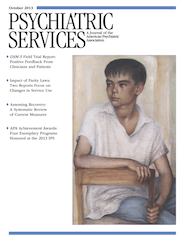Social Realities in China Today: In Reply
In Reply: We were pleased to read Law’s letter. It is exactly the kind of response we seek to achieve—opening many forums for discussion among practitioners, service users, caregivers, researchers, and policy planners in China and beyond. We agree unreservedly that substantially reforming safety-net creation and dealing with issues of social inequity are paramount in order to make real progress in community-based mental health care in China. Although the Internet by itself is not going to lessen the stigma associated with mental disorders in Chinese society, it remains a very useful platform or instrument (especially when used together with “evidence-based, culturally meaningful, and government- and citizen-driven efforts at many levels”) for individuals who are computer literate and troubled by mental health problems and who wish to access credible information about various conditions in the hope of healing and recovery (1,2).
We never pretend to have the answers nor do we underestimate the challenges involved in transforming community-based mental health care in China. On the contrary, we write with the conviction that we are witnessing small pockets of meaningful and novel solutions to lasting social and mental health problems in local communities, although, admittedly, in a scattered fashion (3,4). We are not naïve optimists who expect quick results to be realized in the near future, nor pessimists who think that there is nothing new under the sun. To accomplish this goal, we are challenged to be passionate, contemplative, and scientific (5).
1 : Nature and impact of European anti-stigma depression programmes. Health Promotion International (ePub ahead of print, Jan 24, 2013; doi 10.1093/heapro/das076)Google Scholar
2 : Challenging the public stigma of mental illness: a meta-analysis of outcome studies. Psychiatric Services 63:963–973, 2012Link, Google Scholar
3 : Effectiveness of psychoeducational intervention for rural Chinese families experiencing schizophrenia—a randomised controlled trial. Social Psychiatry and Psychiatric Epidemiology 38:69–75, 2003Crossref, Medline, Google Scholar
4 : Psychiatric services in China: Guangzhou; in Culture and Mental Health: A Comprehensive Textbook. Edited by Bhui KBhugra D. London, Arnold, 2007Google Scholar
5 : Evidence-based practice implementation in community mental health settings: the relative importance of key domains of implementation activity. Administration and Policy in Mental Health and Mental Health Services Research 39:353–364, 2012Crossref, Medline, Google Scholar



